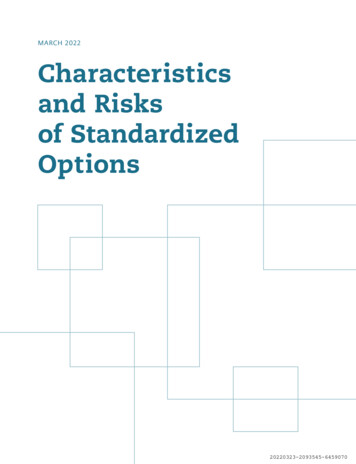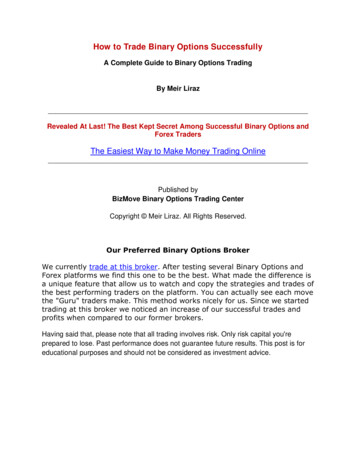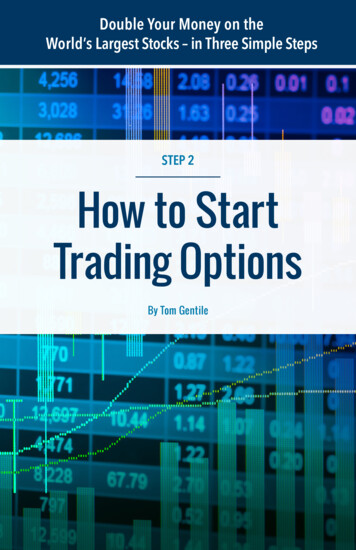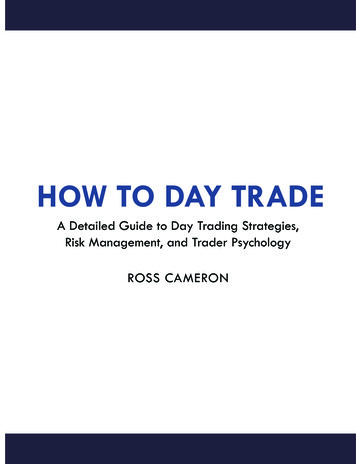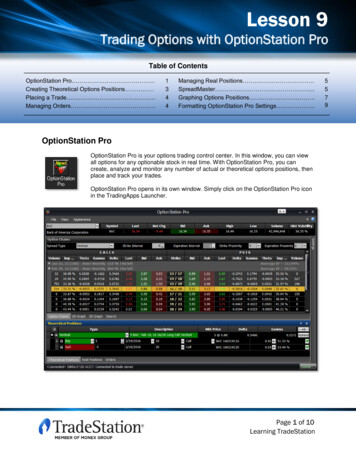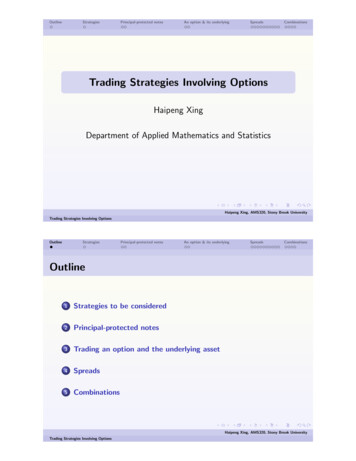
Transcription
OutlineStrategiesPrincipal-protected notesAn option & its underlyingSpreadsCombinationsTrading Strategies Involving OptionsHaipeng XingDepartment of Applied Mathematics and StatisticsHaipeng Xing, AMS320, Stony Brook UniversityTrading Strategies Involving OptionsOutlineStrategiesPrincipal-protected notesAn option & its underlyingSpreadsCombinationsOutline1Strategies to be considered2Principal-protected notes3Trading an option and the underlying asset4Spreads5CombinationsHaipeng Xing, AMS320, Stony Brook UniversityTrading Strategies Involving Options
OutlineStrategiesPrincipal-protected notesAn option & its underlyingSpreadsCombinationsStrategies to be consideredDepending on the trader’s judgement about how prices will move and thetrader’s willingness to take risks, he may choose di erent profit patterns.Bond plus options to create principal protected noteAn option and the asset underlying the optionTwo or more options on the same assetTwo or more options of di erent typesHaipeng Xing, AMS320, Stony Brook UniversityTrading Strategies Involving OptionsOutlineStrategiesPrincipal-protected notesAn option & its underlyingSpreadsCombinationsPrincipal-protected notesOptions are often used to create what are termed principal-protectednotes for the retail market; see the following example (Hull, 2014;Example 12.1).Haipeng Xing, AMS320, Stony Brook UniversityTrading Strategies Involving Options
OutlineStrategiesPrincipal-protected notesAn option & its underlyingSpreadsCombinationsPrincipal-protected notesThe attraction of a principal-protected note is that an investor isable to take a risky position without risking any principal.From the perspective of the bank, the economic viability of thestructure in the last example depends onthe level of interest ratesthe volatility of the portfoliothe level of dividendsHaipeng Xing, AMS320, Stony Brook UniversityTrading Strategies Involving OptionsOutlineStrategiesPrincipal-protected notesAn option & its underlyingSpreadsCombinationsTrading an option and its underlying (a stock)Figure 1: Profit patterns (a) long position in a stock combined with shortposition in a call; (b) short position in a stock combined with long position in acall. (Hull, 2014; Figure 12.1).Haipeng Xing, AMS320, Stony Brook UniversityTrading Strategies Involving Options
OutlineStrategiesPrincipal-protected notesAn option & its underlyingSpreadsCombinationsTrading an option and its underlying (a stock)Figure 2: Profit patterns (c) long position in a stock combined with longposition in a put; (d) short position in a stock combined with short position ina put. (Hull, 2014; Figure 12.1).Haipeng Xing, AMS320, Stony Brook UniversityTrading Strategies Involving OptionsOutlineStrategiesPrincipal-protected notesAn option & its underlyingSpreadsCombinationsSpreads — bull spreadsA spread trading strategy involves taking a position in two or moreoptions of the same type.A bull spread can be created by buying a European call option on astock with a certain strike price and selling a European call optionon the same stock with a higher strike price. Both options have thesame expiration date.Figure 3: Profit from bull spread created using call options (Hull, 2014; Figure12.2).Haipeng Xing, AMS320, Stony Brook UniversityTrading Strategies Involving Options
OutlineStrategiesPrincipal-protected notesAn option & its underlyingSpreadsCombinationsSpreads — bull spreadsBull spreads can also be created by buying a European put with alow strike price and selling a European put with a high strike price.Figure 4: Profit from bull spread created using put options (Hull, 2014; Figure12.3).Haipeng Xing, AMS320, Stony Brook UniversityTrading Strategies Involving OptionsOutlineStrategiesPrincipal-protected notesAn option & its underlyingSpreadsCombinationsSpreads — bear spreadsA bear spread can be created by buying a European put with onestrike price and selling a European put with a lower strike price.Figure 5: Profit from bear spread created using put options (Hull, 2014; Figure12.4).Haipeng Xing, AMS320, Stony Brook UniversityTrading Strategies Involving Options
OutlineStrategiesPrincipal-protected notesAn option & its underlyingSpreadsCombinationsSpreads — bear spreadsBear spreads can also be created by buying a call with a high strikeprice and selling a call with a low strike price.Figure 6: Profit from bear spread created using call options (Hull, 2014; Figure12.5).Haipeng Xing, AMS320, Stony Brook UniversityTrading Strategies Involving OptionsOutlineStrategiesPrincipal-protected notesAn option & its underlyingSpreadsCombinationsSpreads — box spreadsA box spread is a combination of a bull call spread with strike pricesK1 and K2 an a bear put spread with the same two strike prices.If all options are European, the payo from a box spread is alwaysK2 K1 ; see the following illustration (Hull, 2014; Table 12.3).A box-spread arbitrage only works with European options. If alloptions are American, traders are liable to lose money.Haipeng Xing, AMS320, Stony Brook UniversityTrading Strategies Involving Options
OutlineStrategiesPrincipal-protected notesAn option & its underlyingSpreadsCombinationsSpreads — butterfly spreadsA butterfly spread involves positions in options with three di erentstrike prices. (K2 (K1 K3 )/2 is usually close to the currentstock price)Figure 7: Profit from butterfly spread using call options (Hull, 2014; Figure12.6).Haipeng Xing, AMS320, Stony Brook UniversityTrading Strategies Involving OptionsOutlineStrategiesPrincipal-protected notesAn option & its underlyingSpreadsCombinationsSpreads — butterfly spreadsA buttfly spread leads to a profit if the stock price stays close to K2 ,but give rise to a small loss if there is a significant stock price movein either direction.It is a strategy for an investor who fells that large stock price movesare unlikely; see the following table (Hull, 2014; Table 12.4).Haipeng Xing, AMS320, Stony Brook UniversityTrading Strategies Involving Options
OutlineStrategiesPrincipal-protected notesAn option & its underlyingSpreadsCombinationsSpreads — butterfly spreadsButterfly spreads can also be created using put options.Figure 8: Profit from butterfly spread using put options (Hull, 2014;Figure 12.7).A butterfly spread can be sold by following reverse strategy. Optionsare sold with strike prices of K1 and K3 , and an option with themiddle strike price K2 are purchased.Haipeng Xing, AMS320, Stony Brook UniversityTrading Strategies Involving OptionsOutlineStrategiesPrincipal-protected notesAn option & its underlyingSpreadsCombinationsSpreads — calendar spreadsCalendar spreads use options that have the same strike price anddi erent expiration dates.Figure 9: Profit from calendar spread using two call options, calculated attime T1 ( T2 ) (Hull, 2014; Figure 12.8).Haipeng Xing, AMS320, Stony Brook UniversityTrading Strategies Involving Options
OutlineStrategiesPrincipal-protected notesAn option & its underlyingSpreadsCombinationsSpreads — calendar spreadsCalendar spreads can be created with put options as well as calloptions. The profit pattern is similar to that obtained from usingcalls.Figure 10: Profit from calendar spread using two put options, calculatedat time T1 ( T2 ) (Hull, 2014; Figure 12.8).A reverse calendar spread is the opposite to that in Figures 9 and 10.Haipeng Xing, AMS320, Stony Brook UniversityTrading Strategies Involving OptionsOutlineStrategiesPrincipal-protected notesAn option & its underlyingSpreadsCombinationsCombinations — straddleA combination is an option trading strategy that involves taking aposition in both calls and puts on the same stock.A straddle combination involves buying a European call and put withthe same strike price and expiration date.The following straddle is referred to as a bottom straddle or straddlepurchase. A top straddle or straddle write is the reverse position.Figure 11: Profit from a straddle (Hull, 2014; Figure 12.10 & Table 12.5).Haipeng Xing, AMS320, Stony Brook UniversityTrading Strategies Involving Options
OutlineStrategiesPrincipal-protected notesAn option & its underlyingSpreadsCombinationsCombinations — strips and strapsA strip consists of a long position in one European call and twoEuropean puts with the same strike price and expiration date.A strap consists of a long position in two European call and oneEuropean puts with the same strike price and expiration date.In both a strip and a strap, the investor is betting that there will bea big stock price move. However, in a strip, the investor also betsthat a decrease in the stock price is more likely than an increase,and in a strap, the investor also bets that an increase in the stockprice is more likely than a decrease.Haipeng Xing, AMS320, Stony Brook UniversityTrading Strategies Involving OptionsOutlineStrategiesPrincipal-protected notesAn option & its underlyingSpreadsCombinationsCombinations — strips and strapsFigure 12: Profit from a strip and a strap (Hull, 2014; Figure 12.11).Haipeng Xing, AMS320, Stony Brook UniversityTrading Strategies Involving Options
OutlineStrategiesPrincipal-protected notesAn option & its underlyingSpreadsCombinationsCombinations — stranglesIn a strangle, sometimes called a bottom vertical combination, aninvestor buys a European put and a European call with the sameexpiration date and di erent strike prices.Figure 13: Profit from a strangle (Hull, 2014; Figure 12.12 & Table 12.6).In a strangle, the investor bets that there will be a large price move,but is uncertain whether it will be an increase or a decrease.The sale of a strangle is sometimes referred to as a top verticalcombination, and it is approporiate for an investor who feels thatlarge stock price moves are unlikely.Haipeng Xing, AMS320, Stony Brook UniversityTrading Strategies Involving Options
Trading Strategies Involving Options Outline Strategies Principal-protected notes An option & its underlying Spreads Combinations Combinations — straddle A combination is an option trading strategy that involves taking a position in both calls and puts on the same stock. A straddle combination involves buying a European call and put with

